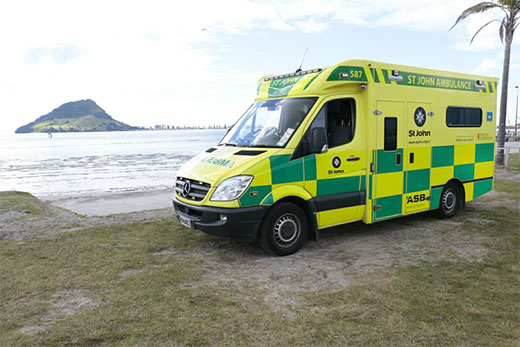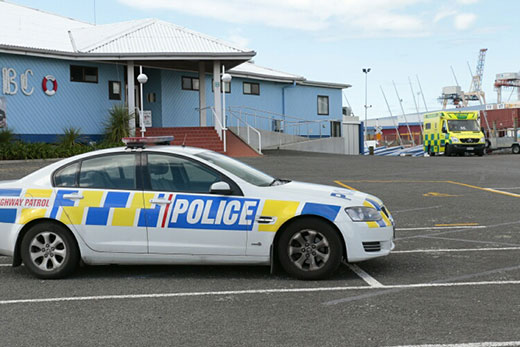Maria Ferrario was having lunch with friends when they saw a man floating in the water past the Tauranga Yacht and Power Boat Club building at the end of Sulphur Point.
Maria is the sailing coach at the yacht club and says even through binoculars, the floating object didn't look like a man at first.
Emergency services at the scene of the near drowing yesterday afternoon. Photos: Bruce Barnard.
'It's not a person, not moving, not shaking hands, maybe a marker buoy or tree,” says Maria speaking to SunLive after rescuing the man from Tauranga Harbour yesterday afternoon.
When Maria thought the bobbing object could be a man's head, she took the club's inflatable boat out to investigate.
'I went just go and see what it is, we went pretty fast,” says Maria.
'He was on the channel very near the ferry, 50 seconds more he would be smashing into the ships.
'We were getting near, not moving, nothing.”

As they got closer they could see it was a person's head, but he couldn't move because of hypothermia.
'He couldn't move any hands, it was shocking. He just moved his eyes but when we got close I was asking ‘what's your name? What are you doing here? And he just said, ‘Can I have a lift?'
'When saw him, we thought like he was dead. It was good he could speak,” says Maria, who is originally from Buenos Aries.
'My friend he has more muscles. I was scared of pulling that person because we didn't know if he was hurt or something. But we pulled the person (into the boat).”
The man was wearing a t shirt and jeans. Maria doesn't think he was a fisherman, or that he went into the water near Sulphur Point.
She thinks it took 15-20 minutes to bring him ashore, where she wrapped him in the foil blanket from the first aid kit.
'The ambulance asked him, ‘What happened? What happened with you?
'And he said, ‘Oh, it's a long story'.
'The police came and they said he's in the middle like he one he's surviving, five he's not surviving. He's in the middle.”
Hypothermia occurs in stages. The progression of the stages is dependent on the overall health of patients, medications they may be taking, the environment, wind chill, and duration of exposure.
When the body is initially exposed to a cold environment, the first response is an increase in metabolism, shivering, and formation of goose bumps.
In the beginning, these responses provide protection from the cold, but they prove inadequate as the body's core temperature continues to decrease and the patient progresses through the five stages of hypothermia:
Stage 1: Shivering
Stage 2: Apathy and decreased muscle function
Stage 3: Decreased level of responsiveness
Stage 4: Decreased vital signs
Stage 5: Death)
Water temperature in Tauranga harbor is currently about 14 degrees C.
A Tauranga Hospital spokesperson says the patient is in a stable condition in hospital.



0 comments
Leave a Comment
You must be logged in to make a comment.